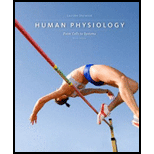
Human Physiology: From Cells to Systems (MindTap Course List)
9th Edition
ISBN: 9781285866932
Author: Lauralee Sherwood
Publisher: Cengage Learning
expand_more
expand_more
format_list_bulleted
Question
Chapter 5, Problem 7RE
Summary Introduction
To Determine:
If the given statement 'the definite function of a precise cortical region will carry out is always fixed during the embryonic development' is true or false.
Introduction:
The cerebral cortex is the convoluted surface layer of the cerebrum gray matter. It functions mainly in the coordination of sensory and motor information. It is formed of tightly packed neurons is wrinkly in structure.
Expert Solution & Answer
Want to see the full answer?
Check out a sample textbook solution
Students have asked these similar questions
please fill in missing parts , thank you
please draw in the answers, thank you
a. On this first grid, assume that the DNA and RNA templates are read left to right.
DNA
DNA
mRNA codon
tRNA anticodon
polypeptide
_strand
strand
C
с A
T
G
A
U
G
C A
TRP
b. Now do this AGAIN assuming that the DNA and RNA templates are read right to left.
DNA
DNA
strand
strand
C
mRNA codon
tRNA anticodon
polypeptide
0
A
T
G
A
U
G с
A
TRP
Chapter 5 Solutions
Human Physiology: From Cells to Systems (MindTap Course List)
Ch. 5.1 - Draw a flow diagram showing the organization of...Ch. 5.1 - Prob. 2CYUCh. 5.1 - Prob. 3CYUCh. 5.2 - Prob. 1CYUCh. 5.2 - Prob. 2CYUCh. 5.2 - Prob. 3CYUCh. 5.3 - Prob. 1CYUCh. 5.3 - Outline the components of the brain from the least...Ch. 5.3 - Prob. 3CYUCh. 5.4 - Prob. 1CYU
Ch. 5.4 - Prob. 2CYUCh. 5.4 - Prob. 3CYUCh. 5.4 - Prob. 4CYUCh. 5.5 - Prob. 1CYUCh. 5.5 - Prob. 2CYUCh. 5.5 - Prob. 3CYUCh. 5.6 - Prob. 1CYUCh. 5.6 - Prob. 2CYUCh. 5.6 - Prob. 3CYUCh. 5.7 - Prob. 1CYUCh. 5.7 - Prob. 2CYUCh. 5.7 - Prob. 3CYUCh. 5.7 - Prob. 4CYUCh. 5.8 - Prob. 1CYUCh. 5.8 - Prob. 2CYUCh. 5.9 - Prob. 1CYUCh. 5.9 - Prob. 2CYUCh. 5.9 - Prob. 3CYUCh. 5.10 - Prob. 1CYUCh. 5.10 - Prob. 2CYUCh. 5 - Prob. 1RECh. 5 - In emergencies when O2 supplies are low, the brain...Ch. 5 - Stellate cells initially process sensory input to...Ch. 5 - Prob. 4RECh. 5 - Prob. 5RECh. 5 - Prob. 6RECh. 5 - Prob. 7RECh. 5 - Prob. 8RECh. 5 - Prob. 9RECh. 5 - Prob. 10RECh. 5 - Prob. 11RECh. 5 - Prob. 12RECh. 5 - Prob. 13RECh. 5 - Discuss the function of each of the following:...Ch. 5 - Prob. 2UCCh. 5 - Prob. 3UCCh. 5 - Prob. 4UCCh. 5 - Prob. 5UCCh. 5 - Prob. 6UCCh. 5 - Prob. 7UCCh. 5 - Prob. 8UCCh. 5 - Prob. 9UCCh. 5 - Prob. 10UCCh. 5 - Prob. 11UCCh. 5 - Prob. 12UCCh. 5 - Prob. 13UCCh. 5 - Prob. 14UCCh. 5 - Distinguish between a monosynaptic and a...Ch. 5 - Julio D., who had recently retired, was enjoying...Ch. 5 - Prob. 1TAHLCh. 5 - Prob. 2TAHLCh. 5 - The hormone insulin enhances the carrier-mediated...Ch. 5 - Prob. 4TAHLCh. 5 - Under what circumstances might it be inadvisable...
Knowledge Booster
Learn more about
Need a deep-dive on the concept behind this application? Look no further. Learn more about this topic, biology and related others by exploring similar questions and additional content below.Similar questions
- Please identify the curve shown below. What does this curve represent? Please identify A, B, C, D, and E (the orange oval). What is occurring in these regions?arrow_forwardPlease identify the test shown here. 1) What is the test? 2) What does the test indicate? How is it performed? What is CX? 3) Why might the test be performed in a clinical setting? GEN CZ CX CPZ PTZ CACarrow_forwardDetermine how much ATP would a cell produce when using fermentation of a 50 mM glucose solution?arrow_forward
- Determine how much ATP would a cell produce when using aerobic respiration of a 7 mM glucose solution?arrow_forwardDetermine how much ATP would a cell produce when using aerobic respiration to degrade one small protein molecule into 12 molecules of malic acid, how many ATP would that cell make? Malic acid is an intermediate in the Krebs cycle. Assume there is no other carbon source and no acetyl-CoA.arrow_forwardIdentify each of the major endocrine glandsarrow_forward
- Come up with a few questions and answers for umbrella species, keystone species, redunant species, and aquatic keystone speciesarrow_forward19. On the diagram below a. Label the three pictures as: DNA; polypeptide; or RNA. b. Label the arrows as: translation or transcription/RNA processing. c. Add the following details to the diagram. Promoter region TATA box Transcription start site Transcription terminator Intron (A,B,C,D) Exons (1,2,3,4,5) Splice sites 5' cap 5' UTR (untranslated region) 3' poly A tail 3' UTR (untranslated region) Translational start (AUG) Translational stop (UGA, UAG, or UAA) N and C ends of polypeptide 0000arrow_forwardMatch the letter labels in the figure below to the terms. Some letter labels are not used. MNNNNNNIN M C B A M D F E H K G 8arrow_forward
arrow_back_ios
SEE MORE QUESTIONS
arrow_forward_ios
Recommended textbooks for you
 Human Physiology: From Cells to Systems (MindTap ...BiologyISBN:9781285866932Author:Lauralee SherwoodPublisher:Cengage Learning
Human Physiology: From Cells to Systems (MindTap ...BiologyISBN:9781285866932Author:Lauralee SherwoodPublisher:Cengage Learning Human Biology (MindTap Course List)BiologyISBN:9781305112100Author:Cecie Starr, Beverly McMillanPublisher:Cengage Learning
Human Biology (MindTap Course List)BiologyISBN:9781305112100Author:Cecie Starr, Beverly McMillanPublisher:Cengage Learning

Human Physiology: From Cells to Systems (MindTap ...
Biology
ISBN:9781285866932
Author:Lauralee Sherwood
Publisher:Cengage Learning




Human Biology (MindTap Course List)
Biology
ISBN:9781305112100
Author:Cecie Starr, Beverly McMillan
Publisher:Cengage Learning

Embryology | Fertilization, Cleavage, Blastulation; Author: Ninja Nerd;https://www.youtube.com/watch?v=8-KF0rnhKTU;License: Standard YouTube License, CC-BY